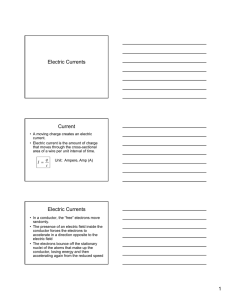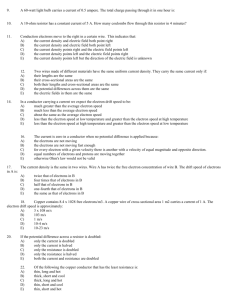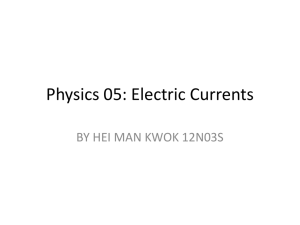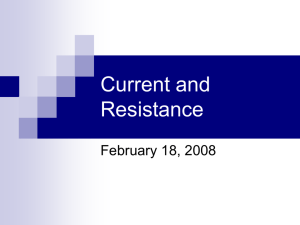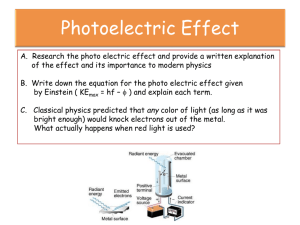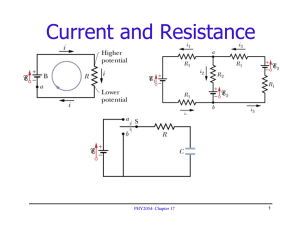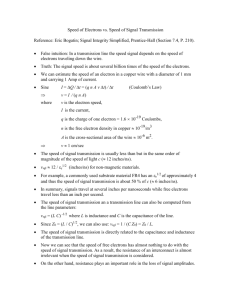Resistance & Resistors
advertisement
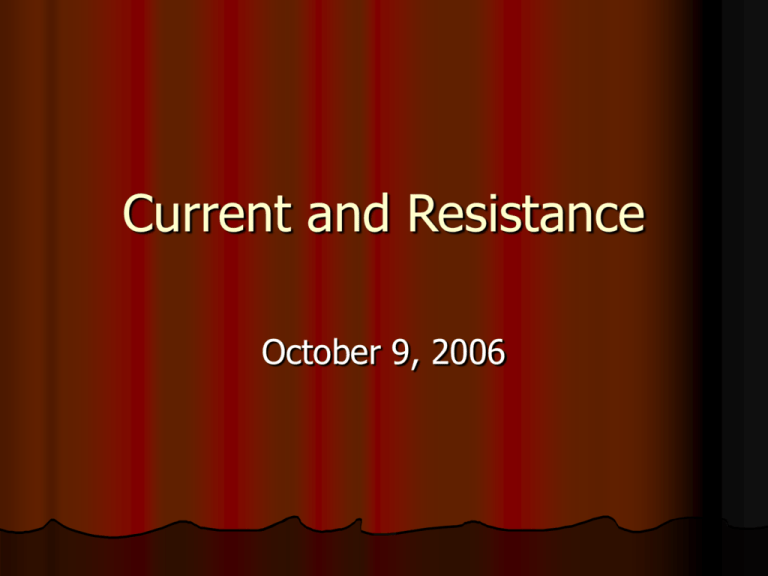
Current and Resistance October 9, 2006 Notes New topic today – Current and Resistance Quiz on Friday Friday 7:30 review sessiomn. There is a new WebAssign. Is it AM or PM … only the shadow knows for sure. I know too. New Topic: Current and Resistance Physical Resistors More … What Happens? “+” REMEMBER, THE ELECTRONS “+” ARE ACTUALLY MOVING THE OTHER WAY! - “+” “+” DEFINITION Current is the motion of POSITIVE CHARGE through a circuit. Physically, it is electrons that move but … Conducting material DQ,Dt Conducting material DQ,Dt CURRENT DQ i Dt or dq i dt UNITS A current of one coulomb per second is defined as ONE AMPERE. Fraggen ….. A small sphere that carries a charge q is whirled in a circle at the end of an insulating string. The angular frequency of rotation is ω. What average current does this rotating charge represent? ANOTHER DEFINITION current I J area A Figure P27.8 represents a section of a circular conductor of non-uniform diameter carrying a current of 5.00 A. The radius of cross section A1 is 0.400 cm. (a) What is the magnitude of the current density across A1? (b) If the current density across A2 is one-fourth the value across A1, what is the radius of the conductor at A2? Ohm A particular object will resist the flow of current. It is found that for any conducting object, the current is proportional to the applied voltage. STATEMENT: DV=IR R is called the resistance of the object. An object that allows a current flow of one ampere when one volt is applied to it has a resistance of one OHM. Graph A DIODE Resistance Varies with Applied Voltage (actually with current) Let’s look at the atomic level .. Conduction is via electrons. They are weak and small and don’t exercise much. Positive charge is big and strong and doesn’t intimidate easily. It’s an ugly situation … something like …… + - Consider a metal conductor So far, we have said that a metal is an equipotential because no charges were moving. Hence, no electric field in the metal You can move a charge freely in the metal BECAUSE there is no electric field. NOW we have a current. This can only happen if we allow an electric field to push the charges. Thus, the metal is NO LONGER A TRUE EQUIPOTENTIAL. But almost …. as we shall see in the next chapter. Vb Va E l The Current Electrons are going the opposite way from the current. (WHY?) They probably follow a path like … Average “drift” speed - vd IN OUT Notation vd average drift velocity of the electron n number of electrons (mobile) per unit volume. Dt interval of time Dx average distance the electron moves in time Dt. Q total amount of CHARGE that goes through a surface of the conductor in time Dt. The Diagram DQ (nAvd Dt )e DQ I avg nAvd e Dt I avg J nevd A J nev d Often a Vector We return to the diagram ….. Consider an electron. Assume that whenever it “bumps” into something it loses its momentum and comes to rest. It’s velocity therefore starts at zero, the electric field accelerates it until it has another debilitating collision with something else. During the time it accelerates, its velocity increases linearly . The average distance that the electron travels between collisions is called the “mean free path”. Starting when the electron is at rest: We showed two slides ago:: v v0 at at F eE a m m eE v vd m Let n= number of charge carriers per unit volume (mobile electrons) eE J nqvd nevd ne m or ne 2 E J E m so ne 2 m 1 Finally vd Reference The average drift velocity of an electron is about 10-4 m/s Ponder How can a current go through a resistor and generate heat (Power) without decreasing the current itself? Loses Energy Gets it back Exit Conductivity In metals, the bigger the electric field at a point, the bigger the current density. J E is the conductivity of the material. =(1/) is the resistivity of the material Going to the usual limit … dI J dA and I JdA Example A cylindrical conductor of radius R has a current density given by (a) J0 (constant) (b) gr Find the total current in each case. 0 1 (T T0 ) Range of and Ye old RESISTANCE DV El 1 DV 1 DV I J E E El l A l DV I A l R A DV V IR REMEMBER R L A DV IR A closed circuit Power In time Dt, a charge DQ is pushed through the resistor by the battery. The amount of work done by the battery is : DW VDQ Power : DW DQ V VI Dt Dt Power P IV I IR I 2 R 2 E P I 2 R IV R Ponder How can a current go through a resistor and generate heat (Power) without decreasing the current itself? Loses Energy Gets it back Exit A Circuit E I (R r) E=emf
